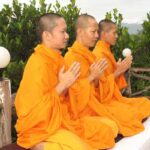The Isaan region and its people, despite their vibrant culture, rich history, and significant contributions to Thailand's society, have unfortunately been subject to negative stereotypes and biases within the broader Thai social landscape. These perceptions have deep historical roots that intersect with factors such as economics, regional disparities, and urban-rural divides.
While some stereotypes may contain kernels of truth, it's important to recognize that they don't accurately represent the diversity and complexity of an entire group. Stereotypes can perpetuate biases, reinforce negative perceptions, and overlook the individuality and positive attributes of people.
When individuals or communities are consistently depicted in negative or demeaning ways, it can have far-reaching consequences. Harmful stereotypes can lead to discrimination, unequal opportunities, social exclusion, and systemic disadvantages.
Stereotypes can shape public perceptions, influencing how people are treated in various spheres of life such as education, employment, healthcare, and housing. They can limit individuals' aspirations and opportunities, leading to self-doubt, reduced self-esteem, and diminished confidence. These negative impacts can create a cycle of disadvantage, making it difficult for affected individuals to break free from these harmful perceptions.
In light of this, I want to address some of the harmful stereotypes that affect the people of Thailand's Isaan region.

Image credit: Peter Holland
1. Socially Inferior
One prevailing stereotype is the misrepresentation of Isaan people as socially inferior or backward. This misconception fails to acknowledge the region's multifaceted contributions to Thai society.
Beyond their vital role in supporting Thailand's agricultural backbone, Isaan people have made significant contributions to various fields that extend well beyond farming. From academia to arts and entertainment, Isaan individuals have demonstrated their capabilities, resilience, and talents, challenging the inaccurate narrative that portrays them as solely defined by their agricultural contributions.
The Bangkok/urban-rural divide often fuels the “socially inferior” stereotype, with urban centers viewing rural areas like Isaan as less developed or less modern. But what does this actually mean? One assumes “less trendy”, “less digitized”, perhaps.
Such attitudes disregard the rural skill-base, resilience, hard work, and ingenuity of Isaan communities who contribute immensely to the nation's economy.
2. Culturally Unsophisticated
Another stereotype is the portrayal of Isaan people as culturally unsophisticated. This perception overlooks the rich tapestry of Isaan's heritage, including its unique dialect, traditional music scene, art and culinary innovations. The region has produced entertainers, scholars, artists, chefs, and sports stars who have made significant contributions to Thai society. Ignoring these accomplishments perpetuates an unfair bias.
As a quick example, two of Thailand's most successful entertainers were born in Isaan. Mum Jokmok, also known as Petchtai Wongkamlao, is arguably the most well-known comedian and actor in Thailand. He was born in Sakon Nakhon province. Also Tony Jaa, real name Panom Yeerum, an internationally renowned martial artist, actor, and film director born in Surin province.
3. Uneducated
It is important to acknowledge that not all people from Isaan are uneducated. While educational opportunities have historically varied between provinces and lagged behind other areas of the country, this is dues to lack of investment from central government, not a lack of potential.
That said, many individuals from Isaan go on to attend university, paving the way for well-paid jobs in areas such as Bangkok and other urban centers. There are numerous private schools across the region, too, as well as some higher level state schools that require good grades to get into.
Furthermore, Isaan boasts several reputable universities, including Khon Kaen University, Mahasarakham University, and Ubon Ratchathani University, among others, which provide quality higher education and contribute to a well-educated workforce. This reflects the diverse range of educational and professional achievements within the Isaan region.
4. Poor
Contrary to the misconception that all Isaan people are uniformly impoverished, the reality showcases a diverse economic landscape within the region. While some areas face economic challenges, it's essential to acknowledge the presence of thriving businesses and prosperous individuals in Isaan. Anyone who has spent considerable time in the region will know that there is a broad spectrum of wealth.
The region has seen remarkable growth and development in recent years, leading to the emergence of successful entrepreneurs, industries, and enterprises. From agricultural ventures to manufacturing and service sectors, Isaan hosts a range of businesses contributing significantly to the local and national economy. By recognizing the economic diversity and success stories within Isaan, we can dispel the oversimplified notion of universal poverty and celebrate the region's economic resilience and potential.
5. “Less Thai”
The Isaan dialect, which is influenced by the Lao language, is different from the central Thai dialect spoken in Bangkok. This linguistic difference can contribute to a perception of Isaan people as having a distinct identity, separate from the broader Thai identity.
Media and popular culture often disproportionately represent central Thai culture, contributing to the idea that central Thai culture is the standard for being “truly Thai.” The limited portrayal of Isaan culture in mainstream media can reinforce the notion that Isaan people are somehow less “Thai.”
In addition Isaan dialect is sometimes stigmatized or ridiculed, leading to the exclusion of Isaan voices and narratives from societal discourse, further marginalizing the region.
6. Low-Skilled Workers
Migration from Isaan to urban centers like Bangkok is a common phenomenon, and many people from the region seek job opportunities in the services industry, such as waiting staff in restaurants and taxi drivers.
While these roles are essential for the urban economy, they are grossly undervalued and those working in such roles are often exploited with low wages and poor working conditions. This can contribute to a broader perception of Isaan people as “lesser than”, and “only good for low-skilled or menial work”.
This degrading mentality overlooks the determination, adaptability, potential and hard work demonstrated by Isaan migrants who contribute significantly to the urban workforce and support their families back in their hometowns.
Addressing these stereotypes requires a comprehensive understanding of the diverse reasons behind migration and work choices. It is essential to respect the agency and aspirations of individuals who migrate for employment opportunities and to challenge the assumptions that underlie negative stereotypes.
7. Sex Workers
The negative stereotyping of the Isaan region extends to the treatment of women, particularly those who have migrated to tourist areas and ended up working in red light districts.
The unfortunate association of Isaan women with the sex industry perpetuates harmful generalizations and objectification. It's crucial to recognize that the reasons for individuals entering such work are complex and often driven by economic circumstances. These stereotypes disregard the diverse aspirations, skills, and potential of Isaan women and detracts from the individual stories and achievements of Isaan women in various fields beyond the confines of the tourist industry.
It is also important to address the impact of foreign sex tourism on perpetuating negative stereotypes. Some foreign sex tourists unfairly label Isaan women with a broad brush, contributing to unfounded and damaging generalizations. It's crucial to understand that the actions of a small minority should not define an entire population.
Lastly, it's important to consider the context and demographics when discussing the sex industry. Isaan comprises approximately one-third of Thailand's population, totaling around 22 million people. With such a significant population, it's logical that the representation of Isaan women working in the sex industry might be disproportionately higher in sheer numbers due to their significant demographic presence. It's also important to note that the sex industry includes women from all over Thailand, not just Isaan – despite their over representation.
In Summary
These negative stereotypes perpetuate social inequalities, hinder social cohesion, and hinder the full potential of Isaan's development. Addressing these biases requires a concerted effort from Thai society to foster understanding, bridge divides, and celebrate the diversity and contributions of all its regions and peoples. By challenging these stereotypes and embracing the rich cultural tapestry of Isaan, Thai society can move towards a more inclusive and unified future.
Last Updated on



JamesE says
But, yes, Bangkok has that same NYC vibe. It's a world city with full rights to look down on everything else.
Sep 30, 2023 at 10:56 pm
Philip says
Sep 27, 2023 at 9:51 pm
TheThailandLife says
Sep 27, 2023 at 9:59 pm
Wes Pederson says
Sep 27, 2023 at 7:42 pm
TheThailandLife says
Sep 27, 2023 at 10:02 pm
Nigel Day says
Sep 27, 2023 at 1:14 pm
Happy Wanderer says
Sep 30, 2023 at 2:39 pm
Jacob Greenspan says
In my limited reading and experience with Thailand, I believe positive and superior stereotypes about Isaan, Is this also "unfair"?
Regarding negative casting, this reveals more about the casters than Isaan.
Sep 13, 2023 at 6:52 am
Happy Wanderer says
Sep 30, 2023 at 2:48 pm